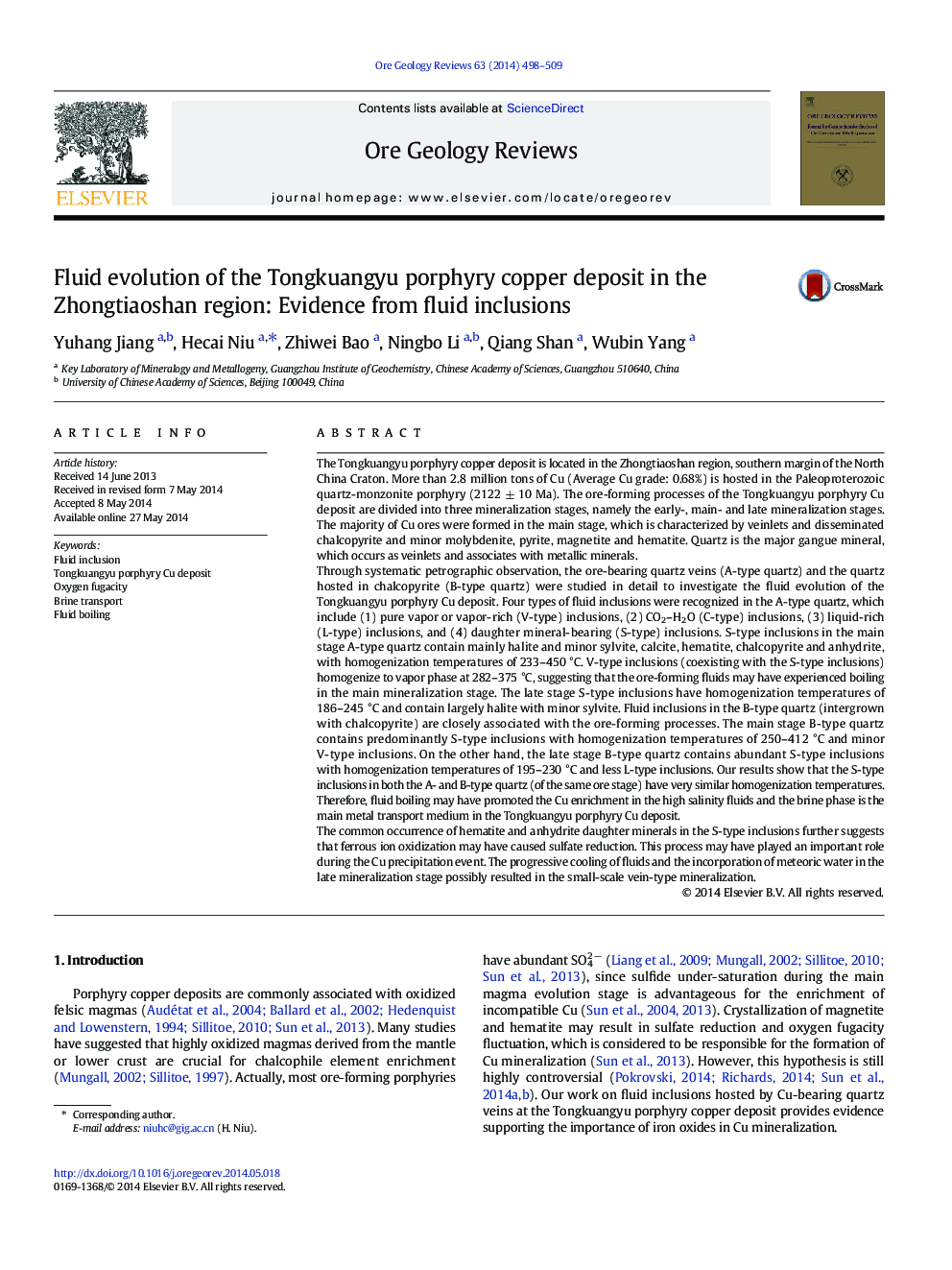| کد مقاله | کد نشریه | سال انتشار | مقاله انگلیسی | نسخه تمام متن |
|---|---|---|---|---|
| 4697225 | 1637240 | 2014 | 12 صفحه PDF | دانلود رایگان |

• High salinity fluids played an important role in the Cu metallogenetic processes.
• Brine is found to be the main Cu transport agent.
• Sulfate reduction triggered by magnetite crystallization was crucial.
The Tongkuangyu porphyry copper deposit is located in the Zhongtiaoshan region, southern margin of the North China Craton. More than 2.8 million tons of Cu (Average Cu grade: 0.68%) is hosted in the Paleoproterozoic quartz-monzonite porphyry (2122 ± 10 Ma). The ore-forming processes of the Tongkuangyu porphyry Cu deposit are divided into three mineralization stages, namely the early-, main- and late mineralization stages. The majority of Cu ores were formed in the main stage, which is characterized by veinlets and disseminated chalcopyrite and minor molybdenite, pyrite, magnetite and hematite. Quartz is the major gangue mineral, which occurs as veinlets and associates with metallic minerals.Through systematic petrographic observation, the ore-bearing quartz veins (A-type quartz) and the quartz hosted in chalcopyrite (B-type quartz) were studied in detail to investigate the fluid evolution of the Tongkuangyu porphyry Cu deposit. Four types of fluid inclusions were recognized in the A-type quartz, which include (1) pure vapor or vapor-rich (V-type) inclusions, (2) CO2–H2O (C-type) inclusions, (3) liquid-rich (L-type) inclusions, and (4) daughter mineral-bearing (S-type) inclusions. S-type inclusions in the main stage A-type quartz contain mainly halite and minor sylvite, calcite, hematite, chalcopyrite and anhydrite, with homogenization temperatures of 233–450 °C. V-type inclusions (coexisting with the S-type inclusions) homogenize to vapor phase at 282–375 °C, suggesting that the ore-forming fluids may have experienced boiling in the main mineralization stage. The late stage S-type inclusions have homogenization temperatures of 186–245 °C and contain largely halite with minor sylvite. Fluid inclusions in the B-type quartz (intergrown with chalcopyrite) are closely associated with the ore-forming processes. The main stage B-type quartz contains predominantly S-type inclusions with homogenization temperatures of 250–412 °C and minor V-type inclusions. On the other hand, the late stage B-type quartz contains abundant S-type inclusions with homogenization temperatures of 195–230 °C and less L-type inclusions. Our results show that the S-type inclusions in both the A- and B-type quartz (of the same ore stage) have very similar homogenization temperatures. Therefore, fluid boiling may have promoted the Cu enrichment in the high salinity fluids and the brine phase is the main metal transport medium in the Tongkuangyu porphyry Cu deposit.The common occurrence of hematite and anhydrite daughter minerals in the S-type inclusions further suggests that ferrous ion oxidization may have caused sulfate reduction. This process may have played an important role during the Cu precipitation event. The progressive cooling of fluids and the incorporation of meteoric water in the late mineralization stage possibly resulted in the small-scale vein-type mineralization.
Journal: Ore Geology Reviews - Volume 63, December 2014, Pages 498–509